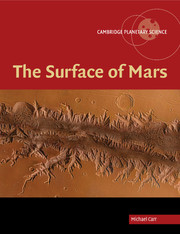7 - Lakes and oceans
Published online by Cambridge University Press: 12 August 2009
Summary
Numerous standing bodies of water of widely different sizes must have accompanied formation of the valley networks and outflow channels. The cratered uplands, in which most of the valley networks occur, are poorly graded. Closed depressions are common. Most are clearly impact craters, ranging in size up to the Hellas basin, but irregularly shaped basins of indeterminate origin are also common. The uplands somewhat resemble fluvially immature terrestrial landscapes, such as the Canadian Shield, where fluvial erosion has not yet eliminated many of the local hollows left by recent glaciation. Most of the hollows in the martian uplands were present at the time that the valley networks formed, as indicated by drainage directions that generally follow the present topography and converge on the hollows. Much of the precipitation that resulted in formation of valleys likely accumulated, therefore, in lakes, at least temporarily.
The possible presence of former seas or oceans on Mars presents us with some of the planet's most intriguing issues. A distinction must be made between possible Noachian oceans and possible post-Noachian oceans. The highly dissected and highly eroded nature of the Noachian uplands strongly suggests that conditions were warm and wet for extended periods of time during the Noachian. If so, then large bodies of water would have been present in low areas such as Hellas and the northern plains, also for extended periods of time. As on Earth, their size would have been controlled by the total near-surface water inventory.
- Type
- Chapter
- Information
- The Surface of Mars , pp. 149 - 172Publisher: Cambridge University PressPrint publication year: 2007



